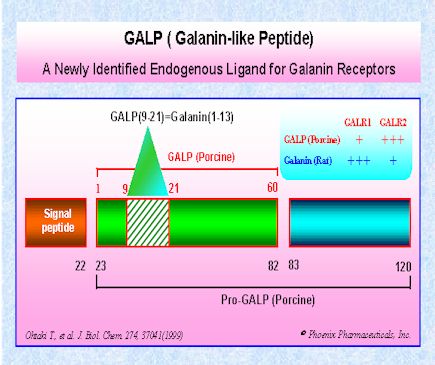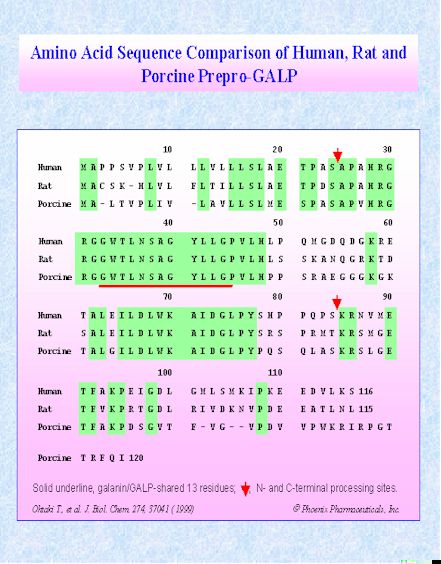Galanin-like
Peptide-A New Obesity Related Peptide
Effects of galanin-like
Peptide on food intake and the hypothalamo-pituitary-thyroid axis
Galanin-like peptide (GALP) is a novel hypothalamic peptide synthesised
in neurons in the arcuate nucleus which project to the paraventricular
nucleus (PVN). GALP has recently been identified as an orexigenic peptide.
In this study we aimed to further characterise the hypothalamic action
of this peptide in energy homeostasis. Firstly, we investigated the orexigenic
effect of GALP in the PVN and compared its effects with galanin and galanin
2-29. Secondly, we examined the effect of PVN administration of GALP and
galanin on circulating thyroid-stimulating hormone (TSH). PVN administration
of GALP significantly increased the food intake of satiated rats 1 h after
administration at doses of 0.3, 1 and 3 nmol. In comparison with paraventricular
administration of galanin, GALP was a more potent orexigen, whereas galanin
2-29, the relatively selective GAL R2 agonist, had no effect on food intake.
Both GALP and galanin administration (1 nmol) into the PVN significantly
decreased the level of circulating TSH. To investigate the mechanism of
these effects, we examined the effect of GALP and galanin application
on neuropeptide release from hypothalamic explants in vitro. GALP peptide
(100 nM) stimulated the release of the orexigenic peptide neuropeptide
Y from hypothalamic explants and decreased the release of the anorectic
peptide cocaine-and-amphetamine-regulated transcript, whereas galanin
(100 nM) peptide had no significant effect on the release of either peptide.
Both GALP (100 nM) and galanin (100 nM) inhibited the release thyrotrophin-releasing
hormone. These data suggest that in the PVN, GALP may play a role in energy
homeostasis by stimulating food intake and suppressing TSH release.
Seth
A, Stanley S, Dhillo W, Murphy K, Ghatei M, Bloom S. Neuroendocrinology
2003 Feb;77(2):125-31
A role for
galanin-like Peptide in the integration of feeding, body weight regulation,
and reproduction in the mouse
Galanin-like peptide (GALP) shares sequence homology with galanin and
binds to galanin receptors in vitro. GALP neurons in the arcuate nucleus
coexpress leptin receptors, and GALP mRNA expression is up-regulated by
leptin. Based on these observations, we postulated that GALP plays a role
in mediating leptin's inhibitory effects on food intake (FI) and body
weight (BW), as well as its stimulatory effect on the reproductive axis.
To test these hypotheses, we performed several studies in which mice received
intracerebroventricular injections of either GALP or vehicle. Acute GALP
treatment elicited a dose-dependent suppression of FI and BW. Long-term
treatment with GALP caused only transient reductions in FI and BW, demonstrating
that the mice became refractory to continued exposure to GALP. GALP inhibited
FI as early as 1 h post injection. Central injection of GALP suppressed
locomotor activity and elicited the formation of a conditioned taste aversion.
In male mice, serum levels of LH and testosterone were increased by GALP
administration. Although we cannot rule out possible nonspecific effects
of GALP on FI, the present observations are consistent with the argument
that GALP is a downstream effector of leptin's actions within the central
nervous system.
Krasnow SM, Fraley
GS, Schuh SM, Baumgartner JW, Clifton DK, Steiner RA. Endocrinology 2003
Mar;144(3):813-22
Galanin-like peptide stimulates
food intake in the rat
We have isolated a novel hypothalamic peptide, Galanin-like peptide (GALP),
as a ligand for galanin receptor subtype GalR2. To investigate the physiological
role of GALP, we examined the effect of the intracerebroventricular administration
of GALP and found that GALP induced food intakes. GALP had ten-fold the
orexigenic activity of galanin. We also observed the anxiogenic-like behavior
after the administration of 1 nmol GALP. These results suggest that GALP
is a novel orexigenic and anxiogenic peptide.
Matsumoto
Y, et. al., Neurosci Lett 2002 Mar 29;322(1):67-9
Centrally administered galanin-like peptide modifies food intake in
the rat: a comparison with galanin
Galanin-like peptide (GALP) is a recently identified neuropeptide that
shares sequence homology with the orexigenic neuropeptide, galanin. In
contrast to galanin, GALP is reported to bind preferentially to the galanin
receptor 2 subtype (GalR2) compared to GalR1. The aim of this study was
to determine the effect of GALP on feeding, body weight and core body
temperature after central administration in rats compared to the effects
of galanin. Intracerebroventricular (i.c.v.) injection of GALP (1 micro
g-10 micro g) significantly stimulated feeding at 1 h in both satiated
and fasted Sprague-Dawley rats. However, 24 h after GALP injection, body
weight gain was significantly reduced and food intake was also usually
decreased. In addition, i.c.v. GALP caused a dose-related increase in
core body temperature, which lasted until 6-8 h after injection, and was
reduced by peripheral administration of the cyclooxygenase inhibitor,
flurbiprofen (1 mg/kg). Similar to GALP, i.c.v. injection of galanin (5
micro g) significantly increased feeding at 1 h in satiated rats. However,
there was no difference in food intake and body weight at 24 h, and galanin
only caused a transient rise in body temperature. Thus, similar to galanin,
GALP has an acute orexigenic effect on feeding. However, GALP also has
an anorectic action, which is apparent at a later time. Therefore, GALP
has complex opposing actions on energy homeostasis.
Lawrence
CB, Baudoin FM, Luckman SM. J Neuroendocrinol 2002 Nov;14(11):853-60


1. Jureus A, Cunningham MJ, McClain ME, Clifton DK, Steiner RA.
Galanin-like peptide (GALP) is a target for regulation by leptin in
the hypothalamus of the rat. Endocrinology 2000 Jul;141(7):2703-6
Galanin-like peptide (GALP), which was recently isolated from the porcine
hypothalamus, shares sequence homology with galanin and binds with high
affinity to galanin receptors. To study the distribution and regulation
of GALP-expressing cells in the brain, we cloned a 120 base-pair cDNA
fragment of rat GALP and produced an antisense riboprobe. In situ hybridization
for GALP mRNA was then performed on tissue sections throughout the forebrain
of adult ovariectomized female rats. We found GALP mRNA-containing cells
in the arcuate nucleus (Arc), caudal dorsomedial nucleus, median eminence
and the pituitary. Because GALP mRNA in the Arc appeared to overlap
with the known distribution of leptin receptor mRNA, we tested the hypothesis
that GALP expression is regulated by leptin. Using in situ hybridization,
we compared the number of GALP mRNA-containing cells among groups of
rats that were fed ad lib or fasted for 48 h and treated with either
leptin or vehicle. Fasting reduced the number of identifiable cells
containing GALP mRNA in the Arc, whereas the treatment of fasted animals
with leptin produced a 4-fold increase in the number of cells expressing
GALP message. The presence of GALP mRNA in the hypothalamus and pituitary
and its regulation by leptin suggests that GALP may have important neuroendocrine
functions, including the physiological regulation of feeding, metabolism,
and reproduction
2. Ohtaki
T, Kumano S, Ishibashi Y, Ogi K, Matsui H, Harada M, Kitada C, Kurokawa
T, Onda H, Fujino M. Isolation and cDNA cloning of a novel galanin-like
peptide (GALP) from porcine hypothalamus.
J Biol Chem 1999 Dec 24;274(52):37041-5
3.
Wang ZL, Kulkarni RN, Wang RM, Smith DM, Ghatei MA, Byfield PG, Bennet
WM, Bloom SR. Possible evidence for endogenous production of a novel
galanin-like peptide.
J Clin Invest 1997 Jul 1;100(1):189-96
|


